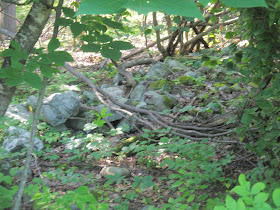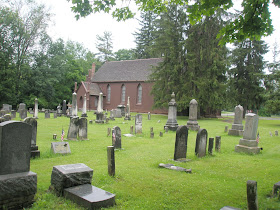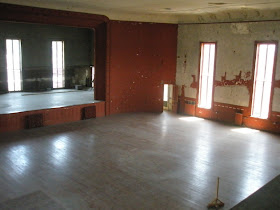UPDATE Nov. 5, 2015:
“The
Witch Girl and the Wobbly” is
a tale of love between a young radical and a wild mountain girl in
the time of the Red Scare and the Flu Epidemic. Inspired by a
successful strike in his home town of Little Falls, Tom Ryan comes to
New York in late 1918 and is befriended by the anarchists Carlo
Tresca and Elizabeth Gurley Flynn. When bombs explode and the
government targets his comrades, Tom accepts an offer to organize the
mills in tiny, upstate Stottville, only to find himself on the run
from a murder charge. Stumbling through the forests along the
Massachusetts border, Tom finds refuge with the Pondshiners, an
isolated mountain community.
The
young materialist at first believes that he has discovered a true
utopia, free from the grasp of the plutocrats he detests, and is
entranced by Lizbeth, the teenaged archer who found him near death in
the forest. She tells Tom of the community's mysterious origins and
their hostility to what she calls “Bible folks.” As their love
grows, he learns that the ancient goddess-centered culture has been
devastated by the recent flu epidemic, and that the surviving men
have become so dangerous that the women refuse to live anywhere near
them. The intrusion of the newly formed State Troopers sets in motion
a series of events that culminate in a mystical experience that Tom
cannot explain.
Searching for the Basketmaker community
From the 1800s into the first decades of the twentieth century, a unique kind of basket, now highly valued by collectors, was produced by a few families who lived in the hills near West Taghkanic, New York.
 Taghkanic basket, currently priced at $975 by
Taghkanic basket, currently priced at $975 by
John Keith Russell Antiques, South Salem NY
 Taghkanic basket, currently priced at $475 at
Taghkanic basket, currently priced at $475 at
Hillsdale Barn Antiques, Hillsdale, NY
No one can say for certain when the basketmakers first established their isolated community in or near what is now Lake Taghkanic State Park, nor how they developed their artistry. They and their way of life are almost forgotten now, and the location of their simple homes are lost in the wooded hills that rise above the rich farmland of Columbia County.
 Chrisler Creek, near the location of the Livingston family's
Chrisler Creek, near the location of the Livingston family's
Maryburgh Iron Forge in New Forge State Forest
 Clermont, home of the wealthy Livingston family who once
Clermont, home of the wealthy Livingston family who once
owned much of southern Columbia County
Perhaps the basketmakers were workers for the Livingstons who stayed in the hills after that wealthy family abandoned its Maryburgh Iron Forge around 1796. Or perhaps they took over unclaimed and undesirable mountain lands during the turmoil of the
Anti-Rent Wars waged by tenant farmers against the Livingstons and the Van Rensselaers in the 1840s. Contemporary accounts describe them as typically very pale and blond, but there are also unverifiable legends of Indian ancestry.
 Millers Tavern in West Taghkanic was built
Millers Tavern in West Taghkanic was built
before 1770 and probably visited by Basketmaker
men during their visits to the hamlet
The families who made the baskets were often named Proper, Hotaling or Simmons, which are very common in the Hudson Valley. The Propers claim descent from the Palatine Germans who settled near Germantown around 1720 and the Hotalings (in many spelling variations) descend form the first Dutch settlers. The hill people thus were closely related to many local families and are said to have a number of descendants still living in Columbia and nearby counties.
 The Basketmakers separated from the Methodist
The Basketmakers separated from the Methodist
Church at West Taghkanic early in the 19th century
It has been nearly twenty years since the final basket was made by the last of the hill country artists, Lizzie Proper, and the unique and irreplaceable Taghkanic baskets now command hundreds of dollars at
Cider Mill Antiques in Red Hook and other shops.
However, the artistic tradition and fierce independence of the Taghkanic basketmakers has not been recognized by any sign, monument or local school curriculum. As far as I can determine, only a single small book celebrates the Taghkanic Basketmakers,
Legend of the Bushwhacker Basket by Martha Wetherbee and Nathan Taylor. The authors are basketmakers with their own shop in New Hampshire who recognized that the skillfully made Taghkanic baskets were not products of Shaker workmanship, as some dealers had claimed. Wetherbee and Taylor identified a unique weaving style as the Taghkanic signature and in the 1980s conducted original research here in Columbia County that forms the basis of their book.
I first became aware of the basketmakers, known locally as either Bushwackers or Pondshiners, through an intriguing comment by Croswell Bowen in his 1941 photographic study,
Great River of the Mountains, recently reprinted by his daughter Lucey Bowen on behalf of the Bannerman Island Trust:
“Resistance to civilization sometimes breaks into violence in this region. Once, when the schoolchildren didn’t like their teacher, they burned down the school house. About the only means of livelihood of the Pondshiners is the weaving of baskets. Most of them cannot read but they tell strange stories which echo from the middle ages.”
Bowen included pictures of an aged couple, Old Yet and Manny Hotailling, “whose world is peopled by goblins and spooks and omens.” He reported that the Hotaillings had been complaining of one of their community, whom they believed to be a witch.
Bowen’s book led me to that of his friend, Carl Carmer, whose 1939
The Hudson included a chapter on what he called the “border people” of the Hudson Valley:
“Back of the brickworks and cement factories at the water’s level, back of the line of towns and great estates that look out over the river, the sides of the Hudson Vallley rise at intervals into steep wooded hills, rock-strewn and desolate. On the edges of these slopes, which are green and beautiful to the passengers on the river boats, live a border people, independent, primitive and in many cases, physically handicapped. They make a poor living these days, from fishing and hunting and basketmaking, but they do not yearn for the things they miss. Occasionally, a traveler may come upon a high pile of baskets making a grotesque moving pattern against the brown earth of a country road and, if he stops, he may see beneath and behind it a wiry little man with quick, sharp eyes and bronzed, wrinkled skin.”
Carmer devoted his chapter entitled "Witches Make Star Tracks" to the supernatural beliefs of the Pondshiners and similar groups. According to him, a belief in witches, and fear of their powers, was universal among the Pondshiners. He knew of the baskets but did not see them as original or of any great value.
The other “sociological islands” on which he commented, such as the Jackson Whites of Ramapo, the Eagles Nesters of Kingston and the Van Guilders of Hudson Falls, were often of mixed Indian, African and white ancestry, similar in many ways to the much better documented
Melungeons of the southern Appalachins. The Melungeons of Tennessee suffered severe discrimination in the days of slavery and Jim Crow, and it was not until Jesse’ Stuart’s evocative novel
Daughter of Legend was published in the 1960s, that their descendants began to celebrate their heritage.
In describing the Pondshiners in the late 1930s, Carmer said that the Propers, Simmonses and other families had come down from “the Hill” where they had lived for generations and settled among the hamlets south of Hudson. He described visiting families in that area who still believed that they were troubled by witches and who showed him a number of injuries they attributed to those malevolent beings.
 Old Yet and Manny Hotailling from Great River of
Old Yet and Manny Hotailling from Great River of
the Mountains by Crosswell Bowen (1941
 Fran Ingals from Great River of the Mountains
Fran Ingals from Great River of the Mountains
by Crosswell Bowen (1941)

Home of one of the Taghkanic basketmakers, from
Great River of the Mountains by Crosswell Bowen (1941)
In his
Great River of the Mountains, Crosswell Bowen reported that Old Yet and Manny Hotailling complained to him about the equally elderly Fran Ingals, whom they accused of all manner of witchery, including souring the milk and sending pitchforks hurtling through the barn. The Hotaillings said that a witch like Fran could only be stopped "drawing a line in the dirt three times around your house" although "sometimes you can spray a flit gun to drive them off."
I was puzzled by the combination of such artistic skill and a belief system hearkening back to the days of the Salem witch trials. Their supposed lack of religion and their "superstition" was commented on by nearly every writer who focused on them. Perhaps the basketmakers practiced their own kind of religion, something akin to what today is called Wiccan?
Their basketry skills were so distinctive as to mark them off as a separate culture, had they been discovered by anthropologists in the Amazon jungle. In what ways, I wondered, did their skills and their beliefs both reflect a common culture?
Certainly, people in the county and beyond did not understand them or their origins. The terms "bushwhacker" and "pondshiner" were insults which the hill people did not apply to themselves. I wondered what beliefs or practices led them to live in isolation for so long and how they reacted to the intrusion of the outside world that began ninety years ago.
In 1919 a journalist by the name of Frederic Van de Water was engaged in writing a history of the newly formed New York State Police, when the troopers were called upon to investigate a series of break-ins at summer homes on Lake Charlotte. (now Lake Taghkanic) A couple of young men in West Taghkanic accused the “Bushwhackers” of the crime. Although the hill people were soon cleared, and their accusers charged with the burglaries, official attention had come to the long isolated community and with it, sensationalistic journalism.
Van de Water accompanied the State Police into the “inaccessible ravine” where the hill people had long lived, away from the notice of the world, and soon published a lurid feature story about them in the New York Tribune. Among the headlines he generated:
The Bushwhackers of Columbia County! Strange People Populate Taghkanic Hills!
They Have No Religion, No Morals, No Education and Run Like Rabbits at the Approach of Strangers - They Eke Out Scanty Existence By Making Baskets
Sixty-two members of two mongrel families, backward as the hill-billies of the South, live only 100 miles from New York City!
Van de Water later collected his sensationalistic accounts of the hill people for a chapter, entitled "The Frightened People," in his 1922 account of the State Police,
Grey Riders.
Weatherbee and Taylor report that such articles on the hill people were regularly published by the New York papers for ten years, from 1919 to 1929, which must have attracted curious and unwanted visitors and done much to end the isolated community’s cultural and artistic traditions. A September 1939 Life magazine article seems to have been one of the last to bring undesired publicity to the basketmakers and included a photograph by the renowned Margaret Bourke-White of “Oldtimer Manny Hotaling holding his insecticide gun which he claims he keeps to ward off the Ghosts of Pondshiners that live around him in the Taghanic hills in the Hudson valley.”
 Manny Hotaling, by Margaret Bourke-White,
Manny Hotaling, by Margaret Bourke-White,
Life, September 1939.
Although basket-making was usually mentioned in all the articles, it was regarded as a low-skilled and primitive activity. Such an attitude could explain why young people among the basketmakers did not continue the craft.
Even before Van de Water’s articles, it appears that the influenza epidemic had devastated the Pondshiners. Van de Water, who evinced no sympathy whatsoever for the hill people, quotes a sergeant who said that “the Flu wiped out about half of them a couple years back” and claimed that they didn’t even know enough to bury their own dead. The sergeant continued, “After all they’re just animals. They’ve slipped so far you couldn’t bring them back. Better if the Flu had wiped them out.”
The almost genocidal attitude expressed the state police sergeant is a good indication why the hill people were so frightened of strangers, and why their descendants generally avoid any acknowledgment of the cultural and artistic traditions of the Basketmakers.
Searching for sites of Pondshiner Settlements
Our attempt to find the location of the Pondshiner settlement began with exploring the hills around West Taghkanic and talking with people, many of whom remembered the basketmakers. Joyce O'Connor told us about Lizzie Proper, who was taught basket-making as a child and returned to the craft as an adult, supporting herself and her daughter. Nancy Griffiths, the Taghkanic town historian, told us that surviving relatives of the basketmakers tend to be shy and reluctant to say anything about their heritage. She recalled that the basketmakers lived near Taghkanic Creek and cut down ash trees for their baskets. The term "bushwhacker," she said, came from the practice of pounding ash wood in the creek in order to make it more pliable.
Relying on The Legend of the Bushwhacker Baskets as a guide, we searched the area south of the state park near Signal Rock, "a great stone ridge that has mysterious connections to the Indians." The authors believed that the region around Lake Taghkanic had significance for the Mohicans and this led them to speculate on an old Mohican connection to the basketmakers. They write about Jacob Lyle, a basketmaker who owned land near the park in 1821 and who they believe may have been a Mohican.
From the nearly extinct hamlet of Jackson Corners, Near Road leads up to Skiba Road, which reaches almost to the slopes of Signal Rock. However, the growth of expensive second homes in this area just off the Taconic Parkway has been accompanied by the fencing off and posting of much of the forest. The access from Green Hill Road off county road 11 is also blocked by private lands.

 Signal Rock is barely visible at the end of Green Hill Road
Signal Rock is barely visible at the end of Green Hill Road
Tom Morgan, a researcher of such communities, suggested some likely locations of “Stove Pipe Alley,” the ravine where the basketmakers had an extensive settlement . There is some disagreement as to which families lived in the ravine. Wetherbee and Taylor tell of a 1798 map that placed Propers and Dykemans in the ravine by 1798. They also quote a 1958 Chatham Courier article that places the arrival of some of the families in Stove Pipe Alley just after the Civil War - an era when iron stovepipes were replacing stone fireplaces.
Tom's study of the Taghkanic Methodist Church records indicated to him that the hill people separated from the church after 1813 and that the Propers and two Hotaling families had become pretty much isolated by the 1830s or 1840s. By the time sensation-seeking journalists descended on the community in the 1920s, no one could say for sure when or why the basketmakers first separated from the outside world.
The next day, we headed west from the hamlet of West Taghkanic on Route 82, where we parked near New Forge Road and headed into a pathless woods a couple miles north of the state park. As we proceeded to ascend a steep ravine, we found three level spots that could have been the locations of cabins and small gardens long ago, but there was little evidence of human habitation beyond some stone walls and a rusted pail.
 Stone walls mark an old boundary on the side of the ravine
Stone walls mark an old boundary on the side of the ravine
 A level spot half way up the ravine
may mark the location of cabins
A level spot half way up the ravine
may mark the location of cabins
 A rusted pail in the ravine
A rusted pail in the ravine
 Stone Table in the ravine, possibly
used for butchering game
Stone Table in the ravine, possibly
used for butchering game
We continued to climb until we reached signs marking the Lake Taghkanic State Park. In 1929 the land for this park was donated to the state by D. McRa Livingston, an heir to the landholding family that once owned most of the county as its own feudal domain. Perhaps the inhabitants of this ravine had been squatting for generations on Livingston land and were simply thrown out when the park was created? Or perhaps they held title to these few acres and received payment for the loss of their homes?
But Wetherbee and Taylor had spoken of a large population, perhaps as many as forty families, who produced thousands of Taghkanic baskets of all varieties over many decades of work. Such a large group could not have lived in this narrow valley.
Pausing to rest about six hundred feet above where we began, it seemed clear to us that this narrow ravine could have only been home to a handful of families, and not to the sixty-two hill people mentioned in the 1920s, nor to the even larger group that existed before the deadly flu epidemic.
The ravine which we had ascended did not exactly match Van de Walker's description, since he said that he and the troopers left their horses at the Lake Charlotte Hotel, which presumably was on the lake now known as Lake Taghkanic. Perhaps this beautiful and isolated spot was not home to the basketmakers at all!
We next turned to the west, once again following Tom's suggestion, and after about three miles came to a priva
te road marked "Stove Pipe Alley." Clearly, this could not be a coincidence! Yet the approaches to the road via county route 8, an old road in existence well before 1919, could easily have been traversed by the troopers' horses. The area could not have been as inaccessible as Van de Water described it - but maybe he had altered the terrain simply to add drama to his story?
As we reached a dead end, beyond which "Stove Pipe Alley" led up into the wooded hills, we were greeted by a trio of fiercely vigilant watchdogs. At this point our imaginations went into overdrive. Did the ancient community still exist in some fashion in these hills? Were the old beliefs still practiced? Or was the road sign simply a way to honor what was once a thriving and unique community?
 "Stove Pipe Alley"
"Stove Pipe Alley"
Staring at the dead end sign that symbolized the frustration of our recent attempts to discover the home of the Taghkanic Basketmakers so mocked by the intruders ninety years ago, we recalled Tom's reminder of the moral necessity of respecting the privacy of the isolated communities and their descendants. We decided, for now, to delay our search for the homes of these forgotten artists.
 A dead end - for now
A dead end - for now










































































